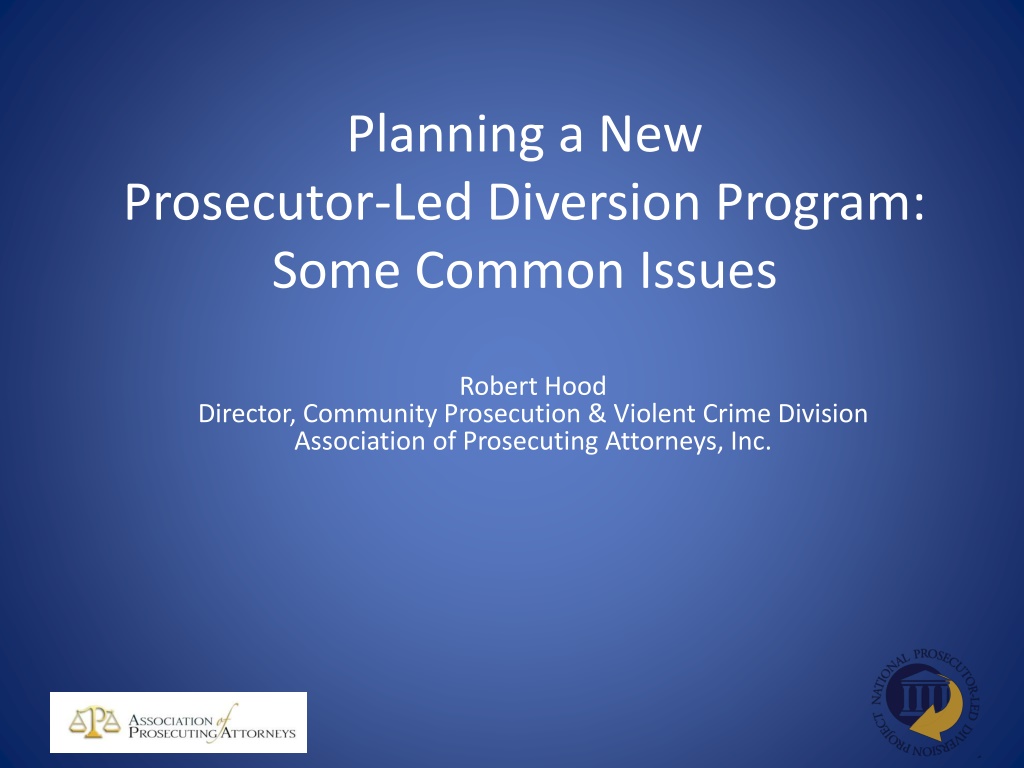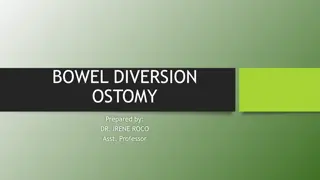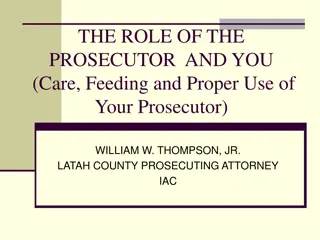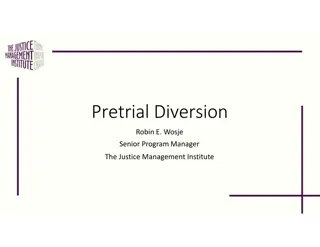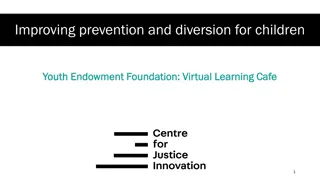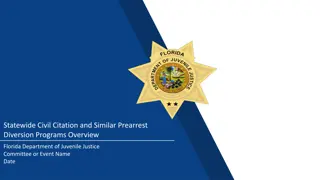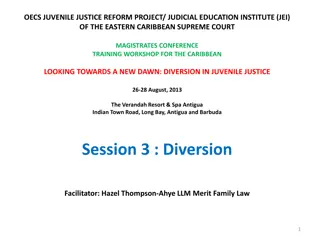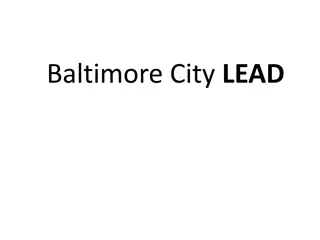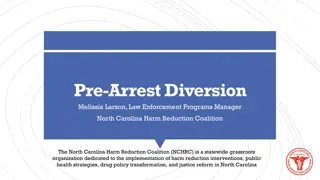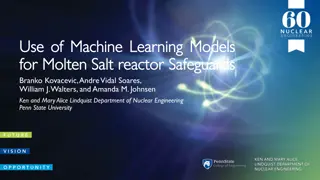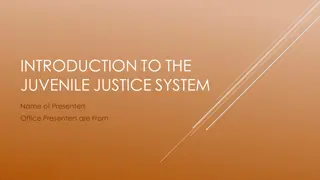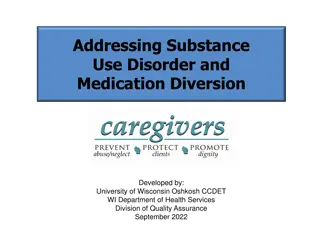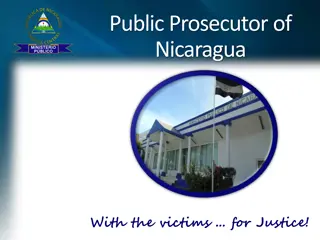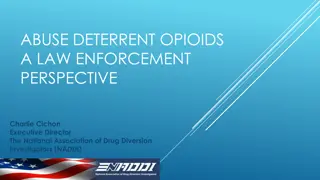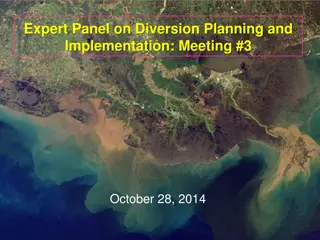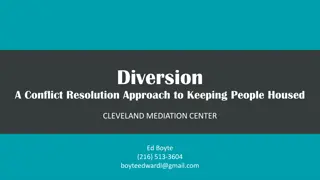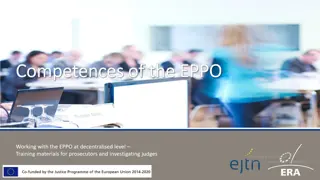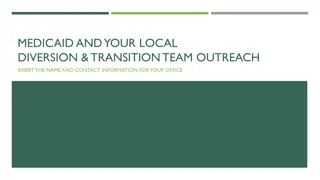Planning a New Prosecutor-Led Diversion Program: Common Issues and Considerations
This presentation explores the concept of diversion, particularly prosecutor-led diversion programs, their history, common issues to consider when planning such a program, and the roles and responsibilities involved. The discussion delves into the meaning of diversion, prosecutor-led diversion, a brief history of these programs, and practical considerations for planning a new initiative. The content emphasizes the importance of understanding eligibility standards, conditions, compliance, and the evolving landscape of prosecutor-led diversion.
Download Presentation

Please find below an Image/Link to download the presentation.
The content on the website is provided AS IS for your information and personal use only. It may not be sold, licensed, or shared on other websites without obtaining consent from the author. Download presentation by click this link. If you encounter any issues during the download, it is possible that the publisher has removed the file from their server.
E N D
Presentation Transcript
Planning a New Prosecutor-Led Diversion Program: Some Common Issues Robert Hood Director, Community Prosecution & Violent Crime Division Association of Prosecuting Attorneys, Inc.
Introduction In this presentation we will discuss: What diversion is. What prosecutor-led diversion is. Review a brief history of prosecutor-led diversion. Identify some of the common issues to consider when planning a new program. Where prosecutor-led diversion is heading. What the BJA/APA Prosecutor Led Diversion Initiative is.
What Does Diversion Mean? Diversion includes programs that are outside of traditional case processing that reduce recidivism and conserve criminal justice resources through interventions tailored to an individual s risks and needs or meaningful and timely responses to their criminal behavior. May be variously referred to as diversion, deferred prosecution, accelerated disposition, pretrial intervention, and other such terms. NAPSA
What is Prosecutor-Led Diversion? Who is primarily responsible for determining: Eligibility standards of the program. Whether an offer is made in a given case. What the program s conditions will be. Whether a person has complied with the conditions. If the answer to these questions is primarily the prosecutor, that program is prosecutor-led.
Brief History of Prosecutor-Led Diversion Diversion began to emerge as early as the 1940 s and proliferated in the 1960 s and beyond. Programs begun before 1990 s tended to be prosecutor-led. Programs begun since 1990 s tended to be court-led. Despite this fact, prosecutor-led diversion programs have continued to provide prosecutors with a non- traditional means to resolve criminal cases throughout. Programs have tended to be post-filing and focus on first-time offenders, and/or those with mental illness and drug use issues. For a more detailed discussion see: No Entry: A National Survey of Criminal Justice Diversion Programs and Initiatives, Center of Health & Justice at TASC, December 2013; and Pretrial Diversion in the 21st Century, NAPSA, 2009.
Planning a Program: Some Common Issues The following questions identify some of the common issues that need to be answered in order to plan a new prosecutor-led diversion program.
Practice Pointer How a prosecutor fashions a program involves a complex weighing of sometimes competing interests involving: Sentencing Philosophy Criminal Justice Case Management Criminal Justice System Resource Concerns Public Safety Victim Interests The burdens and the benefits of a program have clear impacts on the number of people who are eligible for consideration and the number who chose to opt into a program.
Program Goals What are the goals of the program? Save system resources by diverting eligible people out. Avoid costs of conviction-related incarceration. Help people avoid collateral consequences. Give people a second chance . Reduce contact with more seasoned offenders. Provide restorative justice. Expedite case resolution.
Based in Statute, Court Rule, or Policy What is the basis of the existence of the program? Based in Prosecutorial Policy, a Statute or Court Rule. Provision that authorizes the program. Provision that limits eligibility for the program. Provision that limits types of offenses that can be considered for a program. Provision that limits the types of offenses that can be contained in criminal history in order to be eligible.
Plea or Admissions Is a plea/admission required prior to program entry? Formal plea to the charge or charges required. Written admission required. Agreement that offense was committed. None of the above.
Consequences of Failure What are the consequences of program failure? Intermediate sanctions imposed short of revocation. Revocation, plea accepted, sentencing. Revocation, return for trial or plea with admission admissible. Revocation, return for trial or plea.
Crime Type Exclusions Are certain crime types excluded? Are felonies excluded. Are violent crimes*/crimes of violence excluded. Are drug trafficking offenses excluded. Are victim-involved offenses excluded. Are weapons-involved offenses excluded. Are gang-involved offenses excluded. Are domestic violence offenses excluded. *Many states statutorily define what are violent crimes.
Criminal History Based Exclusions Are individuals with certain criminal histories excluded? Does felony criminal history exclude. Does violent crimes/crimes of violence exclude. Does drug trafficking criminal history exclude. Does victim-involved offense criminal history exclude. Does weapons criminal history exclude. Does gang-involved offense criminal history exclude.
Other Situational Exclusions Are there other situational exclusions? Existence of significant mental illness or drug use.* Other pending cases. Existence of a significant amount of restitution. Prior or current diversion. * Some jurisdictions prefer to deal with these cases in their mental health or drug problem-solving court programs.
Timing of Diversion When is the diversion offer extended? Pre-filing. Post-filing but pre-arraignment. Post-arraignment but pre-adjudication.
Restorative Justice Mandates Are restorative justice activities mandated? Specified number of community service hours required. Victim panel or peace-making circle required. Letter of apology required. Reflective writing required. Restitution required.
Program Length What is the length of the program? As short as 30 days to as long as 2 years. Programs with more social services programming tend to run longer. May be lengthened to permit satisfaction of conditions. May be shortened as a reward for good performance or early completion of conditions.
Social Services Mandates Are social services mandated? Drug or alcohol treatment. Mental health treatment. Housing assistance. Employment assistance. Education assistance. Public benefits assistance. Other services.
Risk & Needs Assessment Tools Are the use of a risk & needs assessment tools used to help inform programming or eligibility? Validated screening tool used to assess either risks or needs or both. Non-validated tool used. No screening tool used. Professional judgement over-rides used.
Payment of Costs Are payment of costs required? Complete payment of costs required prior to entry. Partial payment of costs required. Complete payment of costs required prior to program completion. Costs waivable due to indigency. Costs convertible to community service or civil judgement. No costs are imposed.
Victim Consent Required Is the consent of the victim required? Consent of identifiable victim required. Consultation with identifiable victims required. No consent required.
Case Disposition What is the case disposition if successful? Case dismissed or nolle prossed. Charge not filed or reduced. Plea offer withdrawn or rejected.
Ease of Case Expungement What is the ease of case expungement? Expungement of case automatic with case closure. Expungement of case upon request. Expungement of case requires subsequent offender action. Expungement of case via regular expungement statute.
Where is Prosecutor-Led Diversion Heading? Earlier Interventions , more broad-based use. Stronger social services & treatment provider linkages. Greater reliance on risk & needs assessment tools. Application to more challenging populations. Application to more serious crimes. Greater evidenced-based practice. More attention to evaluation and improved practitioner/researcher partnerships. Greater willingness to experiment and innovate.
The BJA/APA Prosecutor-Led Diversion Initiative
The BJA/APA Prosecutor-Led Diversion Initiative What does this training and technical assistance program offer to prosecutors? Intensive training and technical assistance to no fewer than 16 jurisdictions in designing, implementing, and evaluating a new PLD program focused on diverting those with drug & alcohol issues, mental health issues, or who are victims of human trafficking into treatment rather than incarceration. Peer-to peer mentoring through a PLD mentor network. An online toolkit of materials to assist program development. A national assessment of prosecutor s offices use of PLD. Two regional trainings on PLD.
How to Get Help? APA has multiple resources to help assist prosecutors in planning, implementing, and evaluating a new prosecutor-led diversion program. Contact: info@apainc.org
NOTICE OF FEDERAL FUNDING & FEDERAL DISCLAIMER This project was supported by Grant No. 2015-DM-BX-K005 awarded by the Bureau of Justice Assistance. The Bureau of Justice Assistance is a component of the Office of Justice Programs, which also includes the Bureau of Justice Statistics, the National Institute of Justice, the Office of Juvenile Justice and Delinquency Prevention, the SMART Office, and the Office for Victims of Crime. Points of view or opinions in this document are those of the author and do not represent the official position or policies of the United States Department of Justice.
